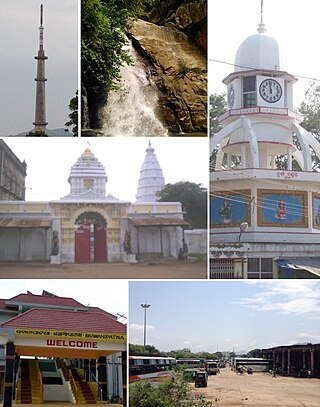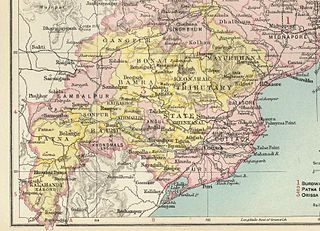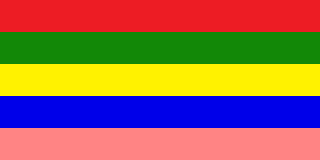
Kalahandi district is a district of western Odisha in India.

Nuapada district is an area of Odisha state in India. Nuapada town is the headquarters of the district. It has one subdivision: Nuapada, and five blocks: Khariar, Sinapali, Boden, Komna, and Nuapada. Nuapada District has three Notified Area Councils: Khariar, Khariar Road, and Nuapada, six tehsils and more villages such as Gandabahali, Tukla, Hatibandha, Duajher, Bargaon, Tarbod, Udyanbandh, and Larka.

Bamra State or Bamanda State, covering an area of 5,149 km2, was one of the princely states of India during the British Raj. Its capital was in Debagarh (Deogarh). Bamra State acceded to India in 1948.

Bhawanipatna is a city and the headquarter of Kalahandi district in the state of Odisha, India. Bhawanipatna has numerous Hindu temples dedicated to different deities. It is named after the presiding deity, Bhabani-Sankar, and Patana, which means "place" in Odia.

Patna State was a princely state in the Eastern States Agency of India during the British Raj. It had its capital at Balangir. Its area was 6,503 km2 (2,511 sq mi).

Manikeshwari Temple is located in Kalahandi district of Odisha, India. The temple is located to the south of Bhawanipatna. The main deity here is Goddess Manikeshwari. She is the Ishta Devi of Nagavanshi Khyatriya's. During Dussehra festival, animal sacrifice is offered at this temple. A film is also documented showing the ritual of animal sacrifice, before Goddess Manikeshwari. Karlapat, which is famous for its charming wild life, is near the temple.
The history of Kalahandi goes back to the primitive period where a well-civilized, urbanized, and cultured people inhabited this land mass around 2000 years ago. The world's largest celt of Stone Age and the largest cemetery of the megalithic age have been discovered in Kalahandi. This shows the region had a civilized culture since the pre-historic era. Asurgarh near Narla in Kalahandi was one of the oldest metropolises in Odisha whereas the other one was Sisupalgarh near Bhubaneswar. Some other historical forts in the region includes Budhigarh, Amthagarh, Belkhandi and Dadpur-Jajjaldeypur. This land was unconquered by the great Ashoka, who fought the great Kalinga War, as per Ashokan record. In medieval period the region had played a prominent role to link South India, Eastern India and Central India region and witnessed the battle ground for Somavamsi, Chola, Kalachuris of Kalyani and Eastern Ganga dynasty. Kalahandi region was the main route for Chola to attack Subarnapur.

Gangpur State, also known as Gangpore State, was one of the princely states of India during the period of the British Raj. Until 1905 it was one of the Chhota Nagpur States under the Eastern States Agency.

Saraikela State also spelt Seraikela, Saraikella or Seraikella, was a small princely state in India during the British Raj, in the region that is now the Jharkhand state. Its capital was at Saraikela.
Bhawanipatna is classified as one of the major tourist destinations by the tourism Department of Government of Odisha. All the tourist attraction in Kalahandi region comes under Bhawanipatna jurisdiction. Though tourist potential of Kalahandi has not been fully exploited, the land is rich in terms of waterfalls, forest and wild life, natural scenery, tribal life, mountains, agriculture field, historical sites and handicrafts. The best time to visit Kalahandi region is from October to March. April–June is hard Summer and temperatures may reach 45 degree C and June to August is the Monsoon Season. While it occasionally rains in September, the Nuakhai festival is help in September and Dassara is held at the end of September or early October. The celebration of Chaitra occurs in February/March.

Manikeswari is one of the popular Hindu deities in Odisha. There are many Manikeswari temples present in Western and Southern part of Odisha.

Hindol State was one of the princely states of India during the British Raj. Its former territory is now part of Dhenkanal district. The state's former capital was the town of Hindol, Odisha. Until 1947, it was not part of British India but was subject to the suzerainty of the British crown, under the Orissa States Agency.

Soroda Estate present day Sorada or Surada, was a zamindari in the North-Western side of Ganjam district of Odisha, India.

The Bhanja dynasty is a dynasty that originated in the northern and central regions of modern Odisha before the Gupta Empire became an imperial power. The dynasty, of ancient local Kshatriya lineage as documented by Hermann Kulke, succeeded the Vindhyatabi branch of the Nagas of Padmavati, who ruled from the Keonjhar district of Odisha and included Satrubhanja of the Asanpat inscription. The Bhanj later became feudatories of the Bhauma-Kara dynasty.

Mayurbhanj State was one of the princely states of India during the British Raj. It was one of the largest states of the Eastern States Agency and one of the four salute states of the Orissa States Agency. The emblem of the state was two peacocks, for according to legend the ancestors of the rulers had originated from a peafowl's eyes.

Khandpara State was one of the princely states of India in the British Raj. It was located in present-day Nayagarh district, Odisha.

Keonjhar State, also known as Keunjhar, was one of the princely states of India during the period of the British Raj. The second largest of the states of the Orissa States Agency, it was located in present-day Kendujhar district, Odisha.
Maharaja Pratap Keshari Deo was an Indian politician. He was the last ruler of Kalahandi State from 1939 to 1947. Post-independence, he was elected from the Kalahandi constituency in Odisha to the Lower House of the Indian Parliament the Lok Sabha. He was deputy Leader of the Opposition, Orissa Legislative Assembly, 1952—1956.


















